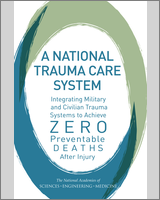| Learning Trauma Care System Component | CASE | CASE |
|---|
| Extremity Hemorrhage | Blunt Trauma with Vascular Injury | Pediatric Burn | Dismounted Complex Blast Injury | Severe Traumatic Brain Injury |
|---|
| Digital Capture of the Trauma Patient Care Experience | Strength(s): Data captured in the Mortality Trauma Registry enabled preventable death studies. | Strength(s): The electronic medical record Theater Medical Data Store was developed. | Strength(s): The Department of Defense Trauma Registry (DoDTR) is now a major resource for analysis of pediatric trauma during wartime and could be used to inform planning for future conflicts. | Strength(s): Prehospital care data are captured in the PreHospital Trauma Registry. | Strength(s): DoDTR data enabled comparison of outcomes with matched cases in the civilian National Trauma Data Bank (NTDB) to identify opportunities for knowledge translation. |
| Gap(s): Patient data are fragmented across multiple systems. | Gap(s): Bandwidth limitations impaired communication of patient data along the continuum of care. | Gap(s): Separate databases exist for prehospital and hospital care. There are no long-term functional recovery and quality-of-life data. | Gap(s): N/A | Gap(s): Entry of pediatric data into the DoDTR was delayed. |
| Coordinated Performance Improvement and Research to Support Evidence-Based Trauma Care | Strength(s): Analyses confirmed improved outcomes with tourniquet use. | Strength(s): Military research on vascular shunts has improved methods for treatment of vascular injuries on the battlefield. | Strength(s): The Burn Resuscitation Decision Support System (BRDSS) was developed. Burn clinical practice guidelines (CPGs) were refined to include issues useful in management of pediatric burns. | Strength(s): Registry analysis confirmed provider reports of an increase in injury frequency. The U.S. Food and Drug Administration (FDA) approved the junctional tourniquet. Research led to the addition of tranexamic acid to the Joint Trauma System (JTS) CPGs, and the JTS continuously monitors data for signs of adverse events. | Strength(s): DoDTR data indicated poor outcomes with hypothermia. Traumatic brain injury (TBI) CPGs were refined as accumulated data and retrospective analysis showed benefit of an aggressive approach. |
| Gap(s): N/A | Gap(s): N/A | Gap(s): There has been very little research to provide high-quality evidence. | Gap(s): Prospective research is needed to validate application to the civilian sector. | Gap(s): N/A |
| Processes and Tools for Timely Dissemination of Trauma Knowledge | Strength(s): Implementation of tourniquet use was encouraged via in-theater conferences, guidelines, training, e-mail, presentations, and publications. | Strength(s): The CPG for complete fasciotomy was developed. Near-real-time feedback to field providers reduced incomplete fasciotomies. | Strength(s): The BRDSS was approved by the FDA. Care was enhanced by the use of teleconsultation programs and a burn phone line. | Strength(s): A new CPG on invasive fungal infection was developed. The CPG on damage control resuscitation was refined. | Strength(s): Use of the JTS severe head injury guideline improved care for these injuries. |
| Gap(s): N/A | Gap(s): Translation to the civilian sector is lagging. | Gap(s): N/A | Gap(s): N/A | Gap(s): Communication about the existence of pediatric equipment and medication kit was lacking. |
| Systems for Ensuring an Expert Trauma Care Workforce | Strength(s): N/A | Strength(s): N/A | Strength(s): The Joint Forces Combat Trauma Management Course was developed. | Strength(s): N/A | Strength(s): N/A |
| Gap(s): Failure to train military personnel on tactical combat casualty care (TCCC) across DoD contributed to preventable deaths due to extremity hemorrhage. | Gap(s): Training on extremity injuries was inadequate. | Gap(s): N/A | Gap(s): N/A | Gap(s): Training does not provide expertise in burn or pediatric care. |
| Patient-Centered Trauma Care | Strength(s): N/A | Strength(s): N/A | Strength(s): N/A | Strength(s): The DCBI Task Force report emphasizes patient-centered, holistic care that included spiritual and psychosocial aspects. | Strength(s): Early multidisciplinary rehabilitation is provided to maximize functional recovery. |
| Gap(s): N/A | Gap(s): N/A | Gap(s): The military is unprepared for the pediatric patient population. | Gap(s): N/A | Gap(s): N/A |
| Transparency and Aligned Incentives for Quality Trauma Care | Strength(s): Feedback to Case 1's unit resulted in immediate training and equipping of unit with tourniquets. | Strength(s): The weekly peer review teleconference provides for the exchange of knowledge and information. CPG compliance is reported. | Strength(s): N/A | Strength(s): N/A | Strength(s): N/A |
| Gap(s): N/A | Gap(s): N/A | Gap(s): N/A | Gap(s): N/A | Gap(s): N/A |
| Leadership and a Culture of Learninga | Strength(s): N/A | Strength(s): N/A | Strength(s): N/A | Strength(s): N/A | Strength(s): N/A |
| Gap(s): Line and medical leadership are not accountable for TCCC training and implementation. | Gap(s): N/A | Gap(s): N/A | Gap(s): N/A | Gap(s): N/A |
